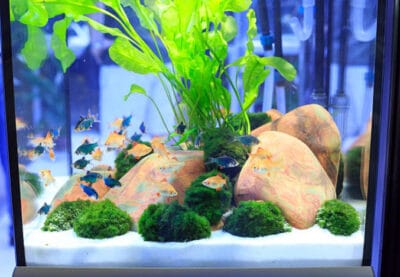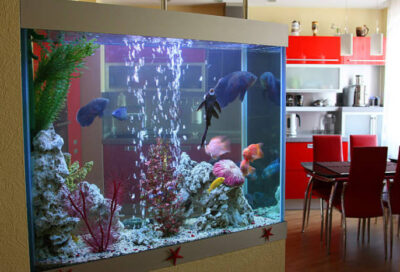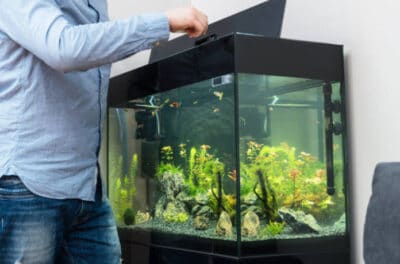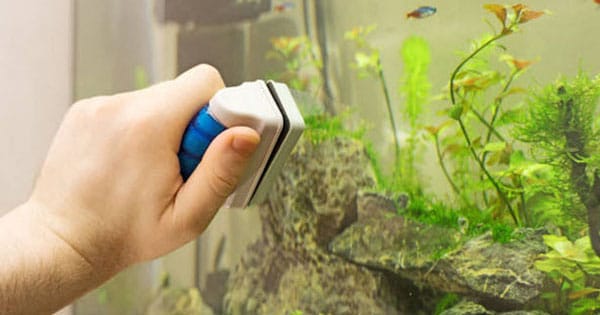Anyone who has owned a fish knows that the fish tank can be the most challenging part of ownership. Between choosing the right tank, setting it up to perfection, and keeping it clean, it can be a daunting task even for the most experienced fish owner. That’s why we’ve set up this guide for how to set up a fish tank. The guide will help ensure that you’re able to pick out, set up, and maintain your fish’s tank, giving them the long, happy life they deserve.
Considerations Of Choosing A Tank

There are several traits to keep in mind when choosing a fish tank, the most important of those being whether the fish living in the tank will be a freshwater or saltwater fish. And, if you’re considering more than one fish, make sure that both of those fish are either freshwater or saltwater, as you can’t have one of each type.
Freshwater Aquariums
If you’ve decided you need a freshwater tank, next it’s important to figure out what characteristic your chosen fish has. Is this a coldwater fish, a tropical fish, an aggressive fish, or a community-oriented fish?
Generally, fish tanks come in two groups: community type tanks and semi-aggressive type tanks. Fish who can get along with other fish can live in a community tank, whereas fish who are in any part aggressive toward other fish will have to live by themselves in semi-aggressive tanks.
It’s also important to note that, unless your tank is very large, it’s not recommended to get multiple fish of the same species, due to both fighting and breeding issues.
Saltwater Aquariums
If you’ve decided that a saltwater aquarium would better fit your needs as a fish owner, you’ll find many options regarding the addition of living organisms in the form of rocks or corals.
A fish-only tank is the least expensive option for saltwater tanks, but the addition of live rocks adds natural biological filtration to the aquarium. With these large rocks, you will find yourself needed to clean and maintain your tank less frequently.
Taking it one step further, you can also make your saltwater tank into a reef tank. In this type of tank, fish are almost an afterthought, with an abundance of live rocks, corals, anemones, and invertebrates. These systems, however cool, are very complicated and expensive, so these types of tanks are usually best left to experienced fish owners.
How To Set Up A Fish Tank

Now that you’ve decided what type of fish tank you’re going to have your fish live in, the next step is setting up your tank! But if you’ve never done it before, figuring out how to set up a fish tank can be challenging, to say the least!
Below you will find a list of the components and accessories you will need to set up your tank, as well as a step-by-step guide to help you put all the pieces together.
Filtration Equipment
One of the most important aspects of your tank will be its filtration system. Filters, like most aspects of your tank, can be customized to you and your fish’s preferences. These customizations include canister filters, power filters, wet or dry filters, or fluidized filters.
All in all, remember to change your filter’s cartridge at least once a month to maintain cleanliness.
Lights
Lights are one of the customizable aspects of your fish’s tank that can be fitted to your personal preference, rather than your fish’s. The quality and quantity of lights you can have, however, depends on your budget.
Colored tube lights are less expensive than LED lights, but the LED lights generally enhance the visual appearance of your tank. You will also be able to add screw-on lights, hang on lights, or clip-on lights, depending on your tank’s fittings.
Heater and Thermometer
A high-quality tank will almost always have a built-in thermostat so you can make sure your fish is always at the optimum temperature, especially during the especially hot or cold months of the year.
If the environment outside your fish’s tank is causing fluctuations in the water temperature, you can get wired or wireless heaters to help maintain a stable temperature.
Aerator or Air Pump
While not the most necessary of items on this list, an aerator will add extra oxygen to the water and keep your fish happy and healthy!
Gravel or Substrate
This is another very important aspect of your fish’s tank because it aids in biological filtration. The gravel provides a home for beneficial bacteria, and while they can grow without the gravel bed, they might not grow in sufficient quantities to keep your fish healthy.
If you do decide to leave your tank’s bottom bare, you will need to change your water more often.
Other decorations can be added to your fish tank, too. Those, once again, are up to the personal choice of the owner!
How To Set Up A Fish Tank

Step One
First, you’re going to want to wash all the components going into your fish tank, including gravel, rocks, and ornaments, with warm water. Do not use soap or detergents, as these are toxic to fish.
Wash the gravel in a colander over a plastic pan. Make sure to stir the gravel, drain, and repeat until the water runs clean and free of debris.
Step Two
Next, you’ll want to fill your tank about one-third of the way full with room temperature water. You can also add a water conditioner to dechlorinate the water and help keep your fish healthy.
Step Three
The next step is to set up your air pump. This is done by connecting the airline tubing from the air pump to the air outlet inside your tank, including any air stones or other decorations.
Step Four
If you’re going to be adding components like live rocks, live plants, or even plastic plants, now is when you’ll add them. Plant the roots of your live plants below the gravel, leaving the crown exposed.
These can also be used to hide your equipment and add to the aesthetic appeal of your tank.
Step Five
This step is easy enough: fill your tank up the rest of the way with water. You want to leave a little bit of space between the surface of the water and the cover of your tank.
Step Six
Now it’s time to set up your filter. The exact process for this step will differ depending on if you’re using an outside filter, or a “hang on tank” filter.
For an outside filter, fill the filter with the cartridge and position it according to the instructions. For a “hang on tank” filter, extend the tube close to the bottom of the tank, and make sure to open the filter lid and fill the filter with water.
Step Seven
The next step is to secure your heater and thermometer. The thermometer should be placed as far away from the heater as possible.
Step Eight
Once everything is in place, it’s time to plug in your air pump, power filter, and heater. Double-check that everything is working properly, making sure that the water is flowing properly through the filter and that the heater is set to the proper temperature.
In general, it’s advised to wait at least 24 hours before adding fish in order to make sure everything is set up properly.
Proper Maintenance Of Your Fish Tank

Now that you’ve set up your fish tank, the next step is to make sure that your fish is thriving in its new environment. And for that to happen, you’ll need to make sure you keep up in maintaining and cleaning your tank.
Problems for your fish and their tank can include overcrowding, overfeeding, and under cleaning. If you find your fish are constantly sick or dying, it’s pretty certain that one of these three things is being done wrong.
You should be cleaning your aquarium at least once a week, during which ten to fifteen percent of the water should be changed, and the glass should be cleaned.
If you have larger fish in your tank that eat more, you might have to change up to fifty percent of the water each time you clean the tank, because these fish will be producing greater amounts of waste.
On the other hand, if you don’t have very many fish in your tank, you have to be cognizant of overfeeding, because this can cause a fish to die.
Generally, larger tanks are more stable for fish. On top of this, they can be cleaned less frequently, making them a good choice for fish owners who don’t want to clean their tank as often.
Best Fish Tanks On The Market

Amid all this information, you might now be tempted to input a Google search for the best tanks you can buy. Have no fear, however, because we’ve included a list of a few of the best aquariums you can buy right now!
SeaClear Acrylic Aquarium Combo Set
Acrylic aquariums are clearer than glass tanks, and are fifteen times as strong! Plus, this combo set includes the aquarium, a reflector, and an electrical light fixture.
You can use freshwater or saltwater in this tank, so it’s fit for either type of fish owner! And, the tank also includes two large openings to fill and scrape with ease.
The external filter of this tank has been reported as “noisy”, so for fish owners looking for a noiseless experience, this aquarium might not be for you.
Tetra 20 Gallon Complete Aquarium Kit w/Filter Heater LED & Plants
This aquarium features a traditional look, natural scenery, and a peaceful aesthetic that will let your fish stand out.
Unlike the tank above, this product has a nearly silent filter that provides dependable water flow. Plus, the Tetra Kit also contains an LED hood that will illuminate the tank completely.
As far as negatives go, some buyers have complained that the tank’s decorative plants are ugly and that the thermometer is bulky and sticks out of the tank.
MarineLand 5 Gallon Portrait Glass LED Aquarium Kit
This tank features a curved design and a 3 stage hidden filtration, an adjustable filter flow pump, and a Bio-foam. The filter is silent, and all wires and cords are hidden, making this tank great for fish owners who want these features masked from view.
The base of this tank, on the other hand, is made of cheap plastic, and the glass cover has some gaps in the front corner.
No matter what type of tank you decide to purchase, rest assured that you will not make a bad choice. As long as you keep in mind the specific components you’re looking for, and follow this guide, your fish will live a long, happy life in a stylish, effective tank.

